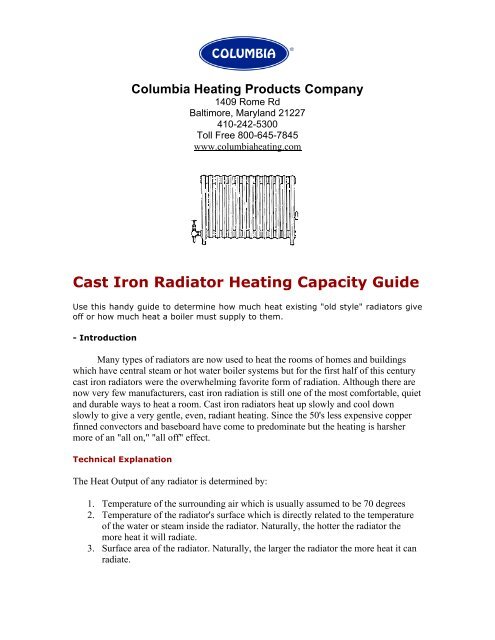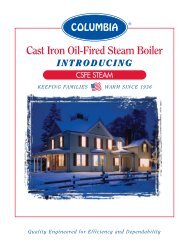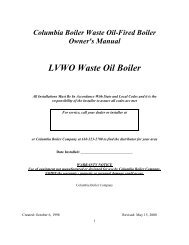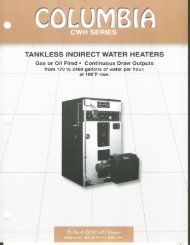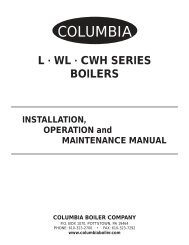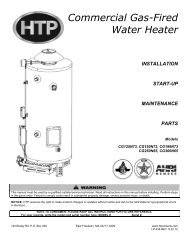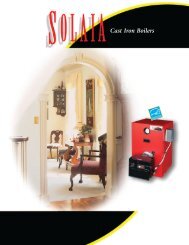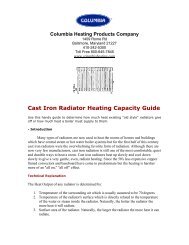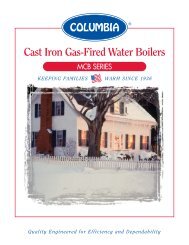Sizing Cast Iron Radiator Heating Capacity Guide - Columbia Heating
Sizing Cast Iron Radiator Heating Capacity Guide - Columbia Heating
Sizing Cast Iron Radiator Heating Capacity Guide - Columbia Heating
Create successful ePaper yourself
Turn your PDF publications into a flip-book with our unique Google optimized e-Paper software.
<strong>Columbia</strong> <strong>Heating</strong> Products Company<br />
1409 Rome Rd<br />
Baltimore, Maryland 21227<br />
410-242-5300<br />
Toll Free 800-645-7845<br />
www.columbiaheating.com<br />
<strong>Cast</strong> <strong>Iron</strong> <strong>Radiator</strong> <strong>Heating</strong> <strong>Capacity</strong> <strong>Guide</strong><br />
Use this handy guide to determine how much heat existing "old style" radiators give<br />
off or how much heat a boiler must supply to them.<br />
- Introduction<br />
Many types of radiators are now used to heat the rooms of homes and buildings<br />
which have central steam or hot water boiler systems but for the first half of this century<br />
cast iron radiators were the overwhelming favorite form of radiation. Although there are<br />
now very few manufacturers, cast iron radiation is still one of the most comfortable, quiet<br />
and durable ways to heat a room. <strong>Cast</strong> iron radiators heat up slowly and cool down<br />
slowly to give a very gentle, even, radiant heating. Since the 50's less expensive copper<br />
finned convectors and baseboard have come to predominate but the heating is harsher<br />
more of an "all on," "all off" effect.<br />
Technical Explanation<br />
The Heat Output of any radiator is determined by:<br />
1. Temperature of the surrounding air which is usually assumed to be 70 degrees<br />
2. Temperature of the radiator's surface which is directly related to the temperature<br />
of the water or steam inside the radiator. Naturally, the hotter the radiator the<br />
more heat it will radiate.<br />
3. Surface area of the radiator. Naturally, the larger the radiator the more heat it can<br />
radiate.
A radiator's relative radiating surface area is measured in terms of Square feet of<br />
"Equivalent Direct Radiation" or "EDR".<br />
There are two types of hydronic heating systems which utilize cast iron radiators:<br />
• Hot water heating systems circulate water heated by a boiler up through the<br />
radiators. The water can be mechanically pushed by a circulating pump or the<br />
system may have been designed to take advantage of the fact that hot water rises<br />
because it is less dense than "cold" water. The latter are called gravity hot water<br />
heating systems. Most of these systems were designed to deliver no more than<br />
180 degree water to the cast iron radiators.<br />
• Steam heating systems for homes make & use steam at very low pressures,<br />
usually under 1 pound per square inch. Steam rises naturally and quickly from the<br />
boiler up to the radiators. When a radiator is filled with this low pressure steam it<br />
can reach a temperature of 215 degrees Fahrenheit.<br />
As mentioned above (#2) and as the following chart shows a radiator's heat output is<br />
directly related to its temperature:<br />
In most cases a Square foot EDR of radiation will emit 240 BTUs per hour on<br />
steam heating systems or 170 BTUs per hour on hot water heating systems. This "rule of<br />
thumb" proves reliable for cast iron radiators as applied in existing homes in the United<br />
States. The above graph shows that these outputs will be higher or lower if the steam or<br />
water within them is hotter or cooler. It will also vary if the radiators are exposed to<br />
blowers or fans and if they are covered or obstructed.<br />
Okay, that's how much heat each square foot of Equivalent Direct Radiation can be<br />
expected to emit in normal home heating design so then...
The TOTAL of the Square feet EDR ratings of all the radiators in a house multiplied by<br />
either:<br />
• 170 BTUs per hour if its a hot water based system or<br />
• 240 BTUs per hour if its a steam system<br />
is how much heat the boiler in the house must deliver to make all of those radiators hot.<br />
Usually that's more than enough heat to keep the house warm - even on the coldest day -<br />
and even enough to dry everyone's wet mittens at the same time!<br />
In fact, when they were built most houses with cast iron radiators weren't very well<br />
insulated and often didn't have storm windows. Since then many have had energy saving<br />
improvements so the total radiator heating capacity is now much greater than the<br />
minimum needed according to the building's actual heat loss. It is, however, very<br />
comforting to really "cook" all those radiators on bitter cold days.<br />
Replacement steam boilers must have enough power to fill every radiator with<br />
steam but replacement hot water boilers for the improved home can be selected according<br />
to the actual heat loss instead of radiator heating capacity if the residents can accept the<br />
lower water and radiator temperature which will result.<br />
This all sounds pretty simple, huh? Well it is, the only trick is determining the EDR<br />
square footage for each radiator.<br />
<strong>Cast</strong> <strong>Iron</strong> <strong>Radiator</strong> <strong>Heating</strong> <strong>Capacity</strong> <strong>Guide</strong><br />
- Looking at a <strong>Radiator</strong><br />
There are three general classifications of radiators found in older homes: Column<br />
Type, Tube Type and Wall Type. More recently cast iron 9" tall baseboard has been<br />
available. First, this guide will demonstrate how to identify and find the EDR ratings for<br />
floor standing column and tube type radiators which are what most of us think of first<br />
when we think of "radiators". Wall type radiators will be discussed afterwards.<br />
Column Type<br />
Tube Type
Wall Type<br />
A traditional cast iron column or tube type radiator is described and measured in terms<br />
of:<br />
1. HEIGHT in inches<br />
2. Number of SECTIONS As you stand in front of a radiator it almost looks like a<br />
loaf of bread. Each cast iron slice is called a section.<br />
3. Number of TUBES or COLUMNS. As you look at a radiator from the narrow end<br />
you can tell that each of the above slices or sections is made up of 1 or more<br />
vertical columns or tubes. The real old ones are about 2 1/2" wide and they are<br />
called COLUMNS. In "newer" radiators these vertical cast iron pipes are only<br />
about 1 1/2" wide and are called TUBES<br />
Right! We really don't care about a floor standing radiator's overall width or depth. So go<br />
ahead. Jot down the number of tubes and sections and the height of every radiator.<br />
5 Tubes, 7 Sections<br />
2 Columns, 7 Sections<br />
Check the next page's table to get the Square feet EDR of one section of each<br />
radiator. Then multiply that by the number of sections in the radiator and you'll have the<br />
Square Foot EDR rating of that radiator. Multiply that total by either 170 Btus per hour<br />
(hot water systems) or 240 BTU’s per hour (steam systems) to get the design heating<br />
capacity of that one radiator. Do the same for all the radiators in that system. The sum of<br />
all these heating capacities is a home's total radiation heating demand on its boiler.<br />
<strong>Cast</strong> <strong>Iron</strong> <strong>Radiator</strong> <strong>Heating</strong> <strong>Capacity</strong> <strong>Guide</strong><br />
- EDR Ratings and Square Feet Per Sections<br />
Column or Tube Type <strong>Radiator</strong> EDR Chart (# of tubes/height)
13" 16" 18" 20" 22" 23" 26" 30" 32" 36" 38" 45"<br />
3 Tubes 1.72 2.00 2.33 3.00 3.50 3.50<br />
4 Tubes 2.25 2.50 2.75 3.50 4.25<br />
5 Tubes 2.67 3.00 3.50 4.33 4.33 5.00 6.00<br />
6 Tubes 3.00 3.50 4.00 5.00<br />
7 Tubes 2.60 3.50 4.20 4.75<br />
1 Column 1.50 1.67 2.00 2.50 3.00<br />
2 Cols. 2.00 2.33 2.67 3.33 4.00 5.00<br />
3 Cols. 2.25 3.00 3.75 4.50 5.00 6.00<br />
4 Cols. 3.00 4.00 5.00 6.50 8.00 10.0<br />
5 Cols. 3.00 3.75 4.50 5.00 6.30 7.00 8.50 10.0<br />
1. Find the Sq. Ft. EDR per section above<br />
2. Multiply by the number of sections altogether in that radiator to get Sq. Ft. EDR<br />
for the entire radiator<br />
3. Multiply by 240 BTUs per hour to get the steam design output<br />
or Multiple by 170 BTUs per hour to get the hot water design output<br />
Forgot how to identify & measure radiators?<br />
Wall <strong>Radiator</strong> EDR Ratings<br />
All wall radiator may be composed of one or more flat wall hung sections. Each<br />
section can be best identified by measuring in inches its height, its width and its depth or<br />
thickness. Jot down those measurements then use the following chart to find the Square<br />
feet EDR of the section closest to those dimensions.<br />
Height Width Thickness EDR<br />
13" 15 5/8" 2 7/8" 5<br />
13" 21 7/8" 2 7/8" 7<br />
22" 13 3/16" 3 1/16" 7<br />
18" 29 1/16" 2 7/8" 9<br />
29" 18 5/16" 3 11/16" 9<br />
Wall <strong>Radiator</strong><br />
1. Find the Sq Ft EDR per section above<br />
2. Multiply by the number of sections altogether in that radiator to get Sq. Ft. EDR<br />
for the entire radiator<br />
3. Multiply by 240 BTUs per hour to get the steam design output<br />
or Multiple by 165 BTUs per hour to get the hot water design output


